|
Michael McFadyen's Scuba Diving - SMS Karlsruhe
SMS Karlsruhe was a light cruiser of the Konigsberg and ordered under the contract name Ersatz Niobe. Her keel was laid down at the Kaiserliche Werft shipyard in Kiel in 1915 (or maybe 1914). She was launched on 31 January 1916 and after fitting out she was commissioned into the High Seas Fleet on 15 November 1916. She was named after the earlier Karlsruhe which had sunk in November 1914 after an accidental explosion. The ship was 151.4 metres long and had a beam of 14.2 metres and a draft of 5.96 metres. She displaced 7,125 tons at full combat load. She was powered by two sets of steam turbines with the steam supplied by ten coal-fired and two oil-fired Marine-type water-tube boilers. These provided a top speed of 27.5 knots and a range of 4,850 nautical at 12 knots.
The ship was armed with eight x 15 cm SK L/45 guns in single pedestal mounts. Two were placed side by side forward on the forecastle, four were located amidships, two on either side and two were arranged in a super-firing pair aft. Karlsruhe also carried two 8.8 cm L/45 anti-aircraft guns mounted on the centreline astern of the funnels. She was also equipped with a pair of 60 cm torpedo tubes with eight torpedoes in deck-mounted swivel launchers amidships. She also carried 200 mines. She was crewed by 17 officers and 458 enlisted men.
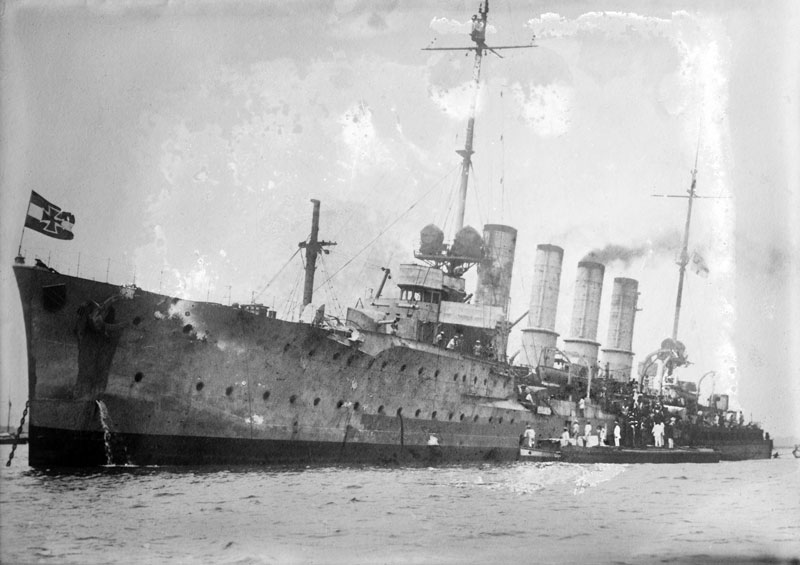 |
| SMS Karlsruhe |
The Karlsruhe appears to have seen no action for the rest of 1916 and for the first seven months of 1917. On 16 August 1917 Karlsruhe participated in a mine-sweeping operation in the North Sea where the minesweepers cleared Route Yellow, one of the channels in the minefields used by U-boats to leave and return to port. Karlsruhe was joined by the cruiser SMS Frankfurt and three torpedo boats for this work. At 12:55 pm lookouts on one of the minesweepers spotted a British squadron of three light cruisers and sixteen destroyers approaching. The minesweepers fled south under a cover of smoke screens and the British broke off the attack. As the Karlsruhe and the rest of the escort failed to come to their aid, the commander of the operation was subsequently relieved of command.
In early September 1917, following the German conquest of the Russian port of Riga, the German navy decided to eliminate the Russian naval forces that still held the Gulf of Riga. The Navy High Command planned an operation to seize the Baltic island of Osel and specifically the Russian gun batteries on the Sworbe Peninsula. The entire force numbered some 300 ships, supported by over 100 aircraft and six zeppelins. There were approximately 24,600 officers and enlisted men in the land-based group. Karlsruhe and the rest of the II Scouting Group provided the cruiser screen for the task force.
The attack began on 12 October 1917 when at 3:00 am the Konig anchored off Osel in Tagga Bay and disembarked soldiers. Around 5:50 am the Konig opened fire on Russian coastal artillery emplacements and was soon joined by the Moltke, Bayern and the other three Konig-class ships, including the Kronprinz. On 18 and 19 October 1917 Karlsruhe and the rest of the II Scouting Group covered minesweepers operating off the island of Dago, but due to an insufficient number of minesweepers and bad weather, the operation was postponed.
 |
| SMS Karlsruhe |
By 20 October 1917 the islands were under German control and the Russian naval forces had either been destroyed or withdrawn. The naval component returned to the North Sea.
Karlsruhe was to have taken part in a final fleet action at the end of October 1918, just days before the Armistice was to take effect. The bulk of the High Seas Fleet was to have sortied from their base in Wilhelmshaven to engage the British Grand Fleet with the idea of inflicting as much damage as possible on the British navy. This was an attempt to get a better bargaining position for Germany in the now certain to come armistice.
Many of the German sailors were sick of the war and felt the operation would disrupt the peace process and prolong the war. On the morning of 29 October 1918 the order was given to sail from Wilhelmshaven the following day. Starting on the night of 29 October 1918, sailors on Thoringen and then on several other battleships, including Kronprinz Wilhelm, mutinied. The unrest ultimately forced the cancellation of the operation.
 |  |
| SMS Karlsruhe | The anchor capstans and forward guns of SMS Karlsruhe |
Along with the most modern units of the High Seas Fleet, Karlsruhe was included in the ships specified for internment by the victorious Allied powers. The ships steamed out of Germany on 21 November 1918 in single file, commanded by Rear Admiral Ludwig von Reuter. They were met at sea by a combined fleet of 370 British, American and French warships. The fleet arrived in the Firth of Forth (Edinburgh) later that day. Then, between 25 and 27 November 1918 they were escorted to Scapa Flow in the Orkney Islands, Scotland. Upon arrival, all wireless equipment was removed from the ships and the breech blocks of their heavy guns were removed to prevent their use. Crews were reduced to minimum levels.
The fleet remained in captivity during the negotiations that ultimately produced the Treaty of Versailles. Reuter believed that the British intended to seize the German ships on 21 June 1919 which was the deadline for Germany to have signed the peace treaty. Unaware that the deadline had been extended to 23 June 1919, Reuter ordered the ships to be sunk at the next opportunity. On the morning of 21 June 1919 the British fleet left Scapa Flow to conduct training manoeuvres, and at 11:20 am Reuter transmitted the order to his ships. Karlsruhe sank at 3:50 pm.
The majority of the German ships were salvaged in the 1920s and 1930s. A number of companies salvaged some wrecks and then Ernest Cox of Cox & Danks raised the majority of the ships. Later work by Metal Industries Ltd in the 1930s raised more. After all this work, only seven of the 52 ships remained, although there are parts of others which are still on the bottom of Scapa Flow. Later salvage work in the 1960s and 1970s by Nandy (Marine Metals) Ltd and then Scapa Flow Salvage Co Ltd under Dougall Campbell removed materials from the remaining ships.
 |  |
A gun from SMS Karlsruhe, salvaged
in 1980s and now at the Lyness museum | Michael swimming along the deck |
The salvage work on the Karlsruhe included remove the props, as well as torpedo tubes and engine turbines.
Today the remains of SMS Karlsruhe lie on the bottom of Scapa Flow at GPS N58ΒΊ 53.8357 W3ΒΊ 11.394' using WGS84. This is about one and a half kilometres north-north-west of the northern point of Cava Island. The maximum depth here is 34 metres and the ship is laying on her starboard side with her bow facing roughly north.
The shotline on the SMS Karlsruhe is located just behind the bow guns. As you descend you will see that the port hull is about 12 to 14 metres deep. Once you reach the wreck, head forward towards the bow. You will see that the two bow guns have fallen down and are now on the sand. It is possible that only the higher port gun has fallen and the starboard one is still in place, I am not sure. The barrels both point forward.
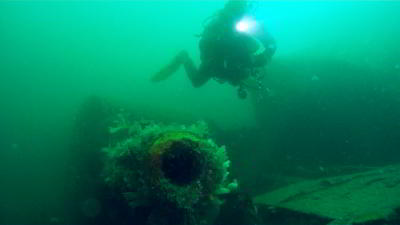 |  |
| Michael and one of the bow guns of SMS Karlsruhe | The breach of the gun at left |
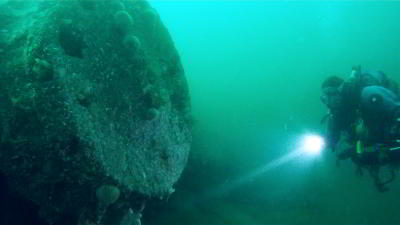 | 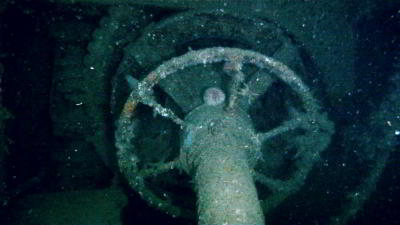 |
| One of the anchor capstans of SMS Karlsruhe | The gears for the anchor capstan below deck |
In front of the guns are two anchor capstans. Again, the higher port one has dropped down. The bow is greatly damaged, with the deck and the floor of the lower deck falling outwards and down. The next deck stands high in place. You can see that the shafts from the two capstans are still in place and run back deep into the ship's hull. You can clearly see the full mechanism of the capstans drive, the worm drive and cog wheels stand out.
From the capstans two anchor chains run through the anchor hawsers and out across the sand to the anchors (not sure how far they are away). Once at the bow you will reach the deepest part of this dive, 25 metres. Come back towards the stern along the shallower port railing area. After about 30 metres you will see the bridge. This is just behind the guns and where you started the dive. Actually, you will probably first see the gun control tower. This very solid structure that you will see on a number of the other wrecks in Scapa.
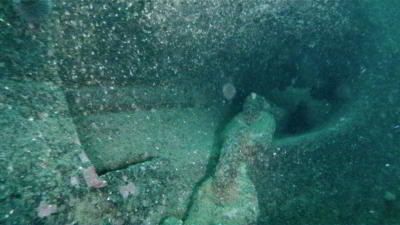 | 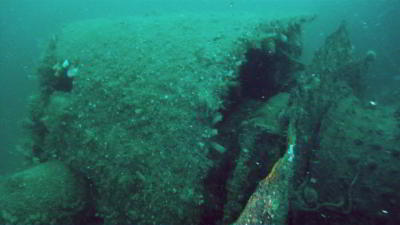 |
| The anchor chain entering the hawser | One of the 5.9 inch bow gun turrets,
including at right the section below the deck |
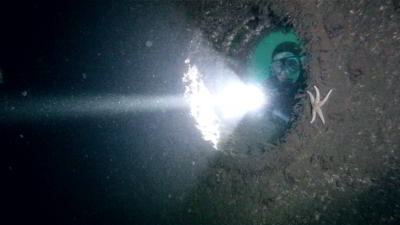 | 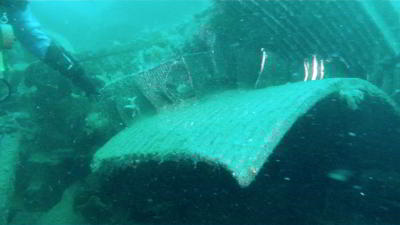 |
| Kelly looking though a hole in the deck | One of the steam turbines |
Behind this are the remains of the bridge. This was built of brass (at least most of it) to reduce interference with magnetic compasses. The brass was salvaged (4.5 tons) by Dougal in the early 1970s as it is very valuable. Here and there you can see pieces that were left behind.
At the rear of the bridge is the main mast which has dropped to the sand. It lays on top of another 5.9 inch gun. While it seems you can only see the breach of the gun, if you look carefully forwards a bit you will see the end of the barrel and notice that it has a plug in it. Back further along the centreline of the ship you can see three oval holes. Like a number of other ships at Scapa, these are where the funnels used to be attached. Inside are the boilers which can be seen if you stick your head inside.
Further along behind the third funnel hole is the engine room salvage cut. This is huge. You can still see parts of turbines, including the blades and the housing. Cross through the salvage area and exit on the bottom of the hull. Follow this towards the stern. It is very colourful as you go as there are millions of jewel anemones attached to the hull. You will soon see the A-frame support for the port (higher) prop shaft, but it is almost hidden by metal hull plates which have been open up. The large rudder is very obvious.
 | 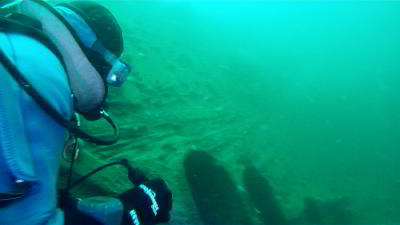 |
| A pair of bollards at the stern |
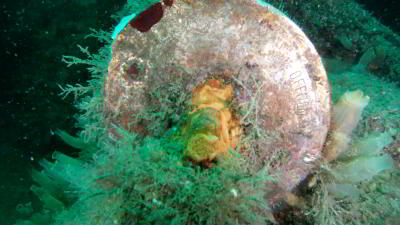 | 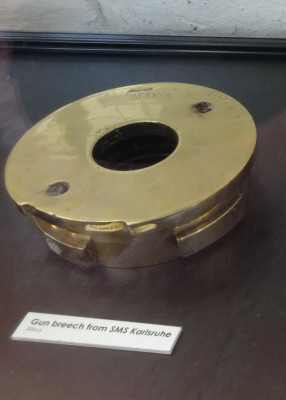 |
| The breach of the bow gun, this says "Offnen", "To Open" | This is a gun breach, the same item as the one at left
It is from the museum at Lyness - Note the wording at top |
The stern is very attractive to look at, very curved in a feminine way almost. There is a kedge anchor still in place on the edge of the deck and the chain runs to an anchor capstan. There are two indents, one either side of the stern. I am not sure what these were for. There are also two sets of bollards and there is also another 5.9 inch gun here which points to the stern. The other gun was salvaged and is now located outside the museum at Lyness.
 |
| A download from my computer showing our profile for the dive from midships to the bow then to the stern and back to midships of SMS Karlsruhe |
From here follow the deck back to the front of the ship. You should have time to examine the guns near the bridge. We probably averaged about 23 metres on this dive and did a bottom time of 41 minutes. Using 32% Nitrox we did not go into deco. A really good wreck that can be completely covered (albeit briefly) in one dive. Visibility was about 10 metres and water temperature 12°.
All underwater photos taken from video using a GoPro camera.
Kelly and I dived with MV Radiant Queen. The owners built a new boat since then which is called MV Huskyan. I would recommend them as we thought the operation was the best overall day charter boat we have used anywhere in the world and the new boat is heaps better than the old one.
Click here to see the list of wrecks
VIDEO
A video made by Kelly of our dive on the Karlsruhe, shot on GoPro.
References:
| 
 v6.00.307 © 2003-2005
v6.00.307 © 2003-2005